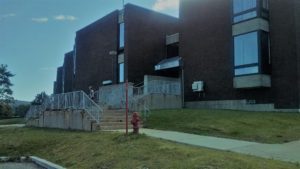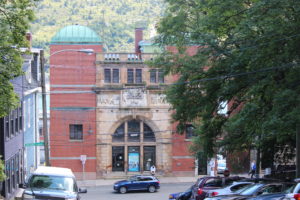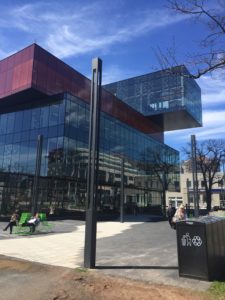
I have a dream of a new public library in the downtown. It is an iconic piece of architecture designed by local architects of considerable talent. The Port Authority and Oceanex have come together and offered up a site on the harbourfront, something akin to the spot designated for the Sydney Opera house in 1955. It rivals The Rooms in scale. It celebrates our culture in its context. It demonstrates what political will can accomplish if only it would put aside the pathetic daily squabbling in order to set holistic direction. A democratic direction. The embodiment of inclusion and higher learning.
Yet I awake, and am confronted with the sadness that is the AC Hunter Library. It is characterized by an exterior entrance that leads to a second level by means of a massive set of steps. It is not barrier free as it is a considerable distance above grade with no ramped access. A tiny elevator designated for staff use connects internal library spaces and permits direct access to the library archives in the basement. It represents the only barrier free means of access, requiring adults with mobility challenges to use the children’s library entrance, even when that library is closed and the adult/reference library is open. A bell is used to alert staff of anyone needing assistance. The door leading into this space offers only 780 mm of clear width – technically insufficient for the passage of a wheelchair.


I used the AC Hunter library extensively is a teen, plagiarizing the reference section for high school assignments and generally just hanging out. It seemed so modern in the early 70’s – a far cry from the ancient Gosling Memorial Library in its historic edifice on Duckworth Street. In the 60’s, I would schlep back and forth from my house on Springdale Street every Saturday to borrow books on dinosaurs and exotic lands.

Not only is the AC Hunter exclusionary based on its physical design, but its location perhaps could not be further removed (a) from those who need it most or (b) from any sort of municipal “ownership”. When the building was designed in 1965/66 by the renowned Canadian architect Ray Affleck, accessibility was not a consideration. In fact, the library was not even a part of the original design program. This was to be a monumental building for Joseph R. Smallwood – his centennial gift to the people of the province.
The bottom line is that the AC Hunter library is sad, outdated, uninspiring and poorly equipped.
But don’t blame Ray. His head was elsewhere.
For many decades of austerity and belt tightening across the globe, libraries were not designed or constructed. In fact, up until the 2000’s the notion of new libraries was counter-intuitive to the way of technology. Books seemed to be in danger of extinction (think Kindle®). Why build a repository for something we no longer have any use for?
But the concept of “library” has evolved. Not only have new library designs put cities on the map as cultural hotbeds, but the programs for such buildings have rapidly re-evolved. They are no longer just warehouses of books and information.
A report prepared by the Netherlands Institute for Public Libraries entitled “The Library of the Future – Hub for Knowledge, Contact and Culture” states:
The core purpose of libraries will be to contribute to and form a foundation for the knowledge and information society. This means stimulating, supporting, facilitating and equipping people with what they need to be able to participate in and contribute to the modern knowledge society.
The report goes on to elaborate on the library as:
1) A centre for development and education.
2) A source of inspiration for reading and literature.
3) A podium for meeting and debate.
4) An encyclopaedia of art and culture.
Urban library architecture now offers up a host of innovative arts support – something desperately needed in St. John’s. Lecture spaces double as performance spaces. Recording studios. Rehearsal rooms. Meeting venues. Gaming and IT forums. Media and program space. Creative music and writing rooms. History and first nations galleries.
And coffee shops.
The new Halifax Public Library has had a major economic impact. Commercial/retail space has grown up around it and there is a real estate demand to be close to the library.
In 2013, the Martin Prosperity Institute (a think tank) calculated that every dollar spent on the Toronto Public Library generated $5.63 in direct tangible benefits and stimulus to Toronto’s economy. Ottawa is about to get a new central library – they are into the architectural short list stage. Calgary is opening a new public library on November 1st – it is lauded as the most anticipated building in Canada for 2018! The new Windsor Park Library in Winnipeg placed special programming emphasis on accessibility and inclusion. Even the Cape Breton Regional Municipality has, this past August, moved to approve a new $28 million library. (We should invade Cape Breton and make Sydney our new capital.)

The municipal and provincial governments responsible for these new facilities must have read the 1996 Book and Periodical Council report entitled: “Dividends: The Value of Public Libraries in Canada”. The document may be somewhat dated but its solid argument remains current. It could not have predicted the paradigm shift in what public libraries now offer.
St. John’s is simply letting all this slide. We are destined to become a backwater. We have not got the means to inspire or retain immigrants. We cannot encourage the less fortunate to better themselves. We continue to skirt the root issues of societal inclusion. We don’t have a facility that will instill learning in our children for fun and fulfillment.
Our provincial politicians in particular, have demonstrated that they are completely clueless on this issue. Consider the impact on education, population retention, innovation, culture, and youth.
Can we just park future electricity rates for minute? Or at least consider the benefits that might accrue if our citizens had a place where they could meet and debate any issue in a positive and supportive atmosphere of community.
